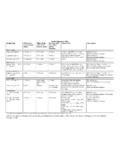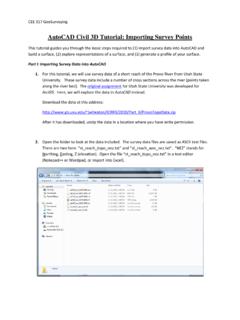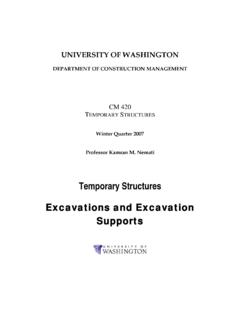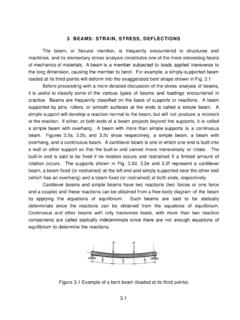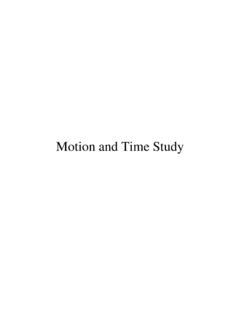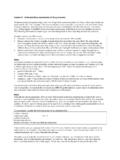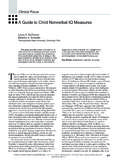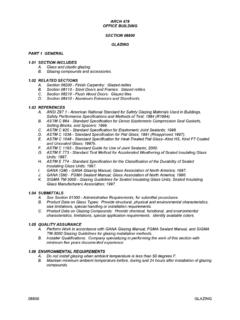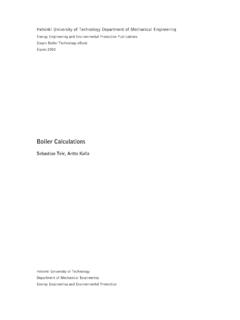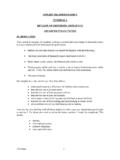Transcription of Aspen Tutorial #4: Thermodynamic Methods
1 32 Aspen Tutorial #4: Thermodynamic Methods Outline: Problem Description Available Thermodynamic Property Methods Recommended Methods for Selected Applications Influence of Thermodynamic Method on Our Problem Problem Description: A mixture containing wt% acetone and wt% water is to be separated into two streams one enriched in acetone and the other in water. The separation process consists of extraction of the acetone from the water into methyl isobutyl ketone (MIBK), which dissolves acetone but is nearly immiscible with water. The overall goal of this problem is to separate the feed stream into two streams which have greater than 90% purity of water and acetone respectively.
2 In our previous tutorials, I have been telling you which Thermodynamic Methods to choose based on that week s update to the simulation. This week we will be covering the many Thermodynamic Methods that are available in Aspen and examining their influence on the results of our simulation. This Tutorial is a little shorter than the previous ones, but the information presented here is one of the most important concepts to understand when using simulation programs. For this reason you should make sure you understand this material Thermodynamic Property Methods : Aspen has four main types of Property Methods : Ideal, Equation of State, Activity Coefficient, and Special Systems. In addition, an advanced user can modify any of these available Methods or create a new property method on their own.
3 Open up your Aspen simulation. Select the Help Topics under Help on the Menu Bar. This will open up the Aspen Plus Help window as shown in Figure 1. On the left hand side of the screen, select the Index tab and type in Property Methods . Select Property Methods in the list on the left hand side and then select the Available Property Methods option. Aspen Tutorial #4 33 Figure 1: Aspen Plus Help You can use the right arrow button to page through the Help window s information on the available Thermodynamic Methods . Hitting it once will bring you to the first group of available Methods , which is the Ideal group, as shown in Figure 2. Thermodynamic phase equilibrium can be determined in a number of ways, including chemical potential, fugacity, activities, activity coefficients, or the equilibrium distribution ratio.
4 You will notice that the Ideal Methods rely on using ideal system equations to calculate the equilibrium distribution ratio (K), which is then used to determine the equilibrium conditions. Index TabArrow ButtonAspen Tutorial #4 34 Figure 2: Ideal Property Methods If you hit the arrow again, the window will move on to the Equation of State Property Methods . These Methods use the various equations of state that are learned about in chemical engineering thermodynamics, to calculate the equilibrium distribution ratio. The two most familiar Methods from this section are listed in the table below. You will also notice that Aspen provides many of the minor variations to the most common Methods ( PRMHV2 a modified Peng-Robinson equation).
5 Table 1: Most Common EOS Property Methods EOS Property Method K-Value Method PENG-ROB Peng-Robinson RK-SOAVE (also SRK) Redlich-Kwong-Soave The next group of available property Methods is the Activity Coefficient group. This group uses various relationships to calculate the liquid phase activity coefficient and then calculate the vapor fugacity using a second relationship. Some of the most common Methods for this group are listed in Table 2. As before, there are many modifications to the basic set of choices, which are useful for specific applications. Aspen Tutorial #4 35 Table 2.
6 Common Activity Coefficient Property Methods Property Method Liquid Phase Activity CoefficientVapor Phase Fugacity NRTL (Non-Random Two Liquid) NRTL Ideal Gas UNIFAC UNIFAC Redlich-Kwong VANLAAR Van Laar Ideal Gas WILSON Wilson Ideal Gas Hitting the arrow button one more time will bring you to the final group of Property Methods .
7 This is the Special Systems group. You will notice that this group provides the available Methods for amine systems, solids systems, and steam systems. This is all the time we will spend here, since our system is not one of these special cases. Recommended Methods for Potential Applications: Selecting the arrow button one more time will bring you to the Choosing a Property Method help screen. The Aspen Plus Help provides two different Methods to suggest the appropriate property Methods . The first of these is a listing of the appropriate Methods for certain industries and the second is a diagram that a user can step through to choose an appropriate method. In this Tutorial we will go through the Recommended property Methods for different applications option.
8 Select that choice in the help window. This will open up the window shown in Figure 3. Use the arrow button to walk through the various applications that are presented here. You will notice that each application is further broken down by the specific operations in that industry. Most of these operations have two or three suggested Thermodynamic Methods . Stop on the Chemicals application screen as this is the industrial application that is most like our particular simulation. Take note of which Thermodynamic Methods most often appear for these applications. We will be testing out a few of them in our simulation, in the final portion of this Tutorial . Aspen Tutorial #4 36 Figure 3: Recommended Property Methods for Different Applications Continue to walk through the other application screens until you have looked at all of them and then close the help window.
9 Influence of Thermodynamic Method on Our Problem: The last time we ran our simulation we used the SRK Thermodynamic method. For our homework this week, we will be comparing the simulation results obtained with this method to those obtained through three other Methods , IDEAL, WILSON, and NRTL. Using what you have learned from the other Tutorials, rerun your simulation with each of the three Thermodynamic Methods listed above. Don t forget to reinitialize your simulation between runs. When you run the case with the WILSON and NRTL Thermodynamic Methods , you will be required to go into the Properties tab in the Data Browser. However, you only need to open up the window Wilson-1 or NRTL-1 under Binary Parameters to allow the default parameters to be recognized as input.
10 You do not need to change any of the values shown in these screens. For the homework assignment, a stream table from each run and a sentence or two highlighting the differences will suffice. Next week: Sensitivity Analysis and Transport Properties Aspen Tutorial #4 37 Tutorial #4 Homework and Solution Question: Compare the simulation results from last week to those obtained with the following three Thermodynamic Methods : IDEAL, WILSON, and NRTL. Show the stream table results for each Thermodynamic method and write a sentence or two summarizing your findings. Solution: SRK Results (last week): Tutorial 4 Stream IDFEEDM-A1 MIBK1 PRODUCT1 VAPPROD1W-A1Te m p er a tu reF 7 5.

